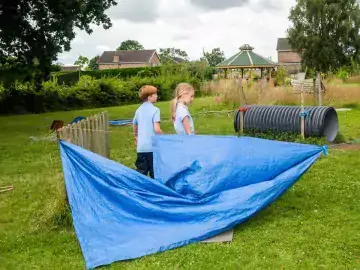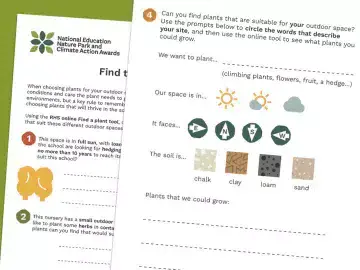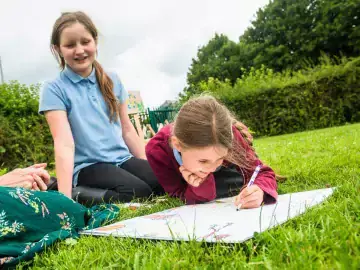
Ideas for improvement
After Exploring your site, a key part of the Nature Park programme is thinking about what actions will improve your learning site for biodiversity – but how do you know where to start?
This activity introduces a range of challenges and opportunities that you may experience on your site, along with a selection of different ‘intervention cards’ for children and young people to consider as solutions. These might be nature-based solutions, like the creation of a green wall, or activities that you could take on to raise awareness and support of your vision, like a fundraiser.
This activity encourages design thinking and supports discussion around the types of ideas and solutions that could be effective, suitable and feasible for your site, to reach your goals. There is also the opportunity for learners to get creative and design their own improvements.
Preparation
What you need
- Challenges PowerPoint slides
- Improvement cards (one set per group of learners)
- Blank improvement cards
- Pencils and coloured pencils
- Optional: A3 paper for mind mapping
Location
Inside
Useful guidance
Step by step
- To begin, display and talk through the PowerPoint of scenarios. These give a sample of the kinds of challenges and opportunities many learning sites may face. As you present each challenge, ask learners if they think this is a challenge faced on your site – where do we experience this challenge? Do we have anything similar? How does it impact us? How does it impact nature? (If you have already mapped your site, you could view your map together and assess different areas.)
- You can deliver this activity by working together to select the top challenge you’d like to choose improvements for, or split learners into smaller groups and assign each group a different challenge.
- Hand out a set of improvement cards to each group (this might be in their usual seating arrangement, or moving to work in groups of about 5). These cards display a selection of interventions – these may be nature-based solutions, design solutions, or social or creative actions that you and learners can consider to improve your outdoor spaces. Explain to learners that they will be selecting the best cards for their chosen challenge.
- To introduce the concept, you could start with some quick prompts, asking each group to hold up a selected card when chosen, for example:
“Find a card that is good for wildlife.”
“Find a card that will have instant impact.”
“Find a card that is good for people’s wellbeing.”
You could combine prompts, for example, “find a card that is good for wildlife and climate.” - Next, give 15 minutes for each group to choose the best three interventions for their chosen challenge – what needs improving? What do the improvements need to be able to do? You could provide each group with a sheet of A3 paper and pencils to mind map their ideas.
- If learners need some help, ask them to think about: What needs to change to help us with this challenge? How would the improvements impact local nature? How would they impact the young people, teachers and staff on site?
- After the 15 minutes, ask groups to feed back their choices and discuss as a class – what has made them choose these improvements? Look at similarities and differences between the improvements chosen by each group. Are some cards more popular than others? Why?
- You could also ask learners to use the blank card templates to design their own improvements for a particular problem or challenge. They could combine some of the existing examples to create a new one! Pin up these designs onto a board or wall to share everyone’s ideas and act as inspiration throughout your Nature Park journey.
Reflection
Discuss with learners, “What makes something a good improvement? What do we need to make sure we are thinking about when deciding how to improve our site for nature and people?” (For example, spaces that are fun, spaces that are safe, seeing more birds, having flowers for pollinators) You could collect thoughts and words on a board or flipchart.
Curriculum links
This activity can be used to support curriculum knowledge and skill development in science, geography and citizenship, alongside enhancing nature education, with age appropriate adaptations.
What to try next

Life-size planning
Begin activity
Find that plant!
Begin activity